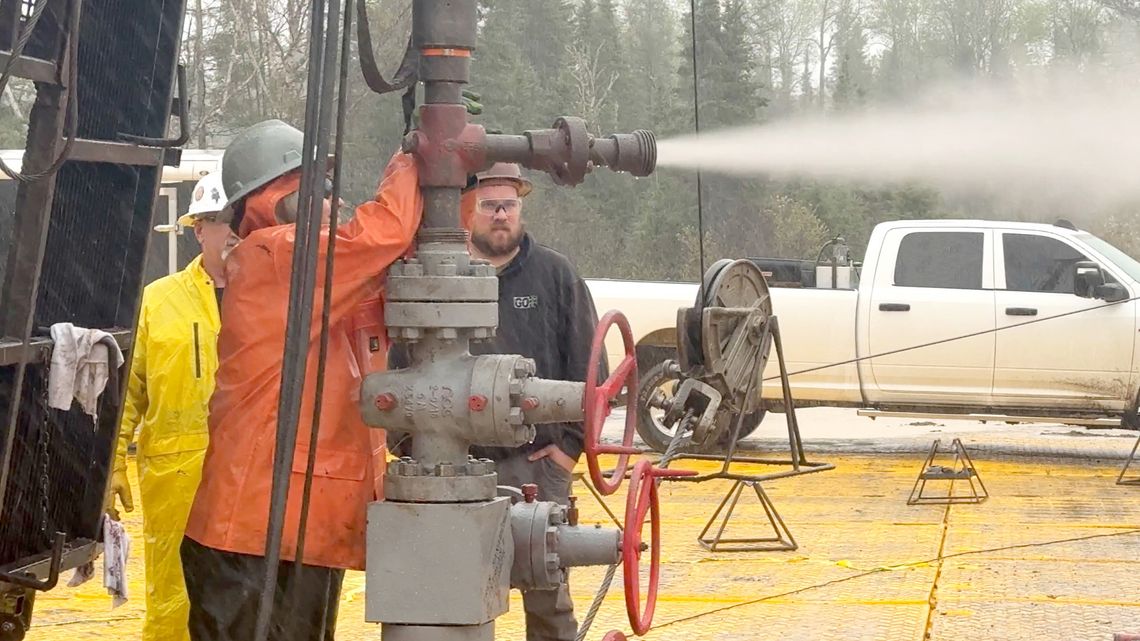Pulsar Helium announced the safe and timely completion of logging, completion and flow testing activities at the Jetstream appraisal well at its flagship Topaz helium project.
A summary of the results:
• Helium and associated gases flowed to surface naturally in a free gas phase,
• Flow testing after clean up recorded a maximum rate of 821 thousand cubic feet per day (Mcf/d),
• New laboratory results from produced gas confirm concentrations between 8.7 – 14.5% helium,
• CO2 concentrations exceeding 70% have the potential to contribute to project economics,
• Vertical Seismic Profile (VSP) and wireline optical televiewer data was collected, and
• In-fill Airborne Gravity Gradiometry (AGG) survey flown.
“The results of the Jetstream flow test and laboratory analysis confirm a major new helium discovery, putting Topaz in the top tier of global primary helium projects,” said Pulsar president and CEO, Thomas Abraham-James.
“The comprehensive dataset acquired will give the company the assurance it needs to fast track activities and realize Topaz’s commercial potential. The data will be analyzed by Sproule for their updated resource estimate, along with recommendations for future appraisal and development planning at Topaz.
“This is the first dedicated helium well drilled in Minnesota, and all data gathered indicates that this is not an isolated occurrence with the helium-bearing zone likely to extend laterally and at depth.”
Proposed future work
The Jetstream #1 appraisal well was designed to replicate the original 2011 discovery. This was successful and the existing seismic data suggests that the helium- bearing zone persists at depth, up to an additional kilometer (3,281 feet).
Future work programs are proposed to consist of deepening Jetstream to assess this potential, in conjunction with drilling a nearby stepout well and conducting a 3D seismic survey to define the structural extent of the resource.
Flow Testing
Completion and initial flow testing activities have been finalized at the Jetstream appraisal well. The flow test program included five flow tests of both natural flow and under wellhead compression from the open-hole section of the well (between 503-671 meters (1,650–2,200 feet) depth).
Each test lasted approximately six hours in duration with pressure build-ups of 18 hours between natural flow tests and approximately six days until the start of the compression tests.
The flow test with well site compression reached a maximum absolute open flow of 821 Mcf/d at a flowing tubing head pressure of 20 psi on a one inch choke.
Results during natural flow climbed to a peak of 150 Mcf/d with 34 psi flowing tubing head pressure on a one inch choke with the rate still on incline at the six-hour shut-in mark.
Following well tests, tubing head pressure built up rapidly to near pre-flow conditions.
Laboratory Analysis
Gas samples were collected throughout the flow testing operations and were distributed to Isotech Laboratory, the Woods Hole Oceanographic Institute, and Caltech Noble Gas Lab.
The results from Isotech have been received with up to 14.5% helium measured, prior to any atmospheric contamination correction. An average of 9.9% helium was derived across 21 samples.
Associated major gases include CO2 content of up to 71%, nitrogen up to 24%, and hydrocarbons constituting <5% of the total gas content. Gas isotope analysis will take place later in June for detailed gas chemistry investigation.
Logging / Data Acquisition
Data acquired during the recent activities includes both downhole and broader site data, as follows:
• An optical televiewer was run through the open hole portion of the Jetstream by Inner Earth Technologies. Preliminary interpretation of the high-resolution image data confirms a series of fractures within the open-hole section of the well across a 19 meter (62 foot) gross interval.
• A downhole vertical seismic profile (VSP) was acquired at Jetstream by Baker Hughes and their partner SAExploration. The VSP gathers data on acoustic rock properties and provides a seismic image at the well location for depth correlation to future seismic imaging. In conjunction with the VSP, SAExploration conducted a series of seismic sweeps in the vicinity of Jetstream to facilitate the design of future seismic acquisition.
The company will provide a further update on independent evaluations of the Jetstream well data as additional material information is received.
Data acquired during the past three weeks will assist with understanding of the Topaz resource, future potential production performance, facility design, and regional work program planning.











